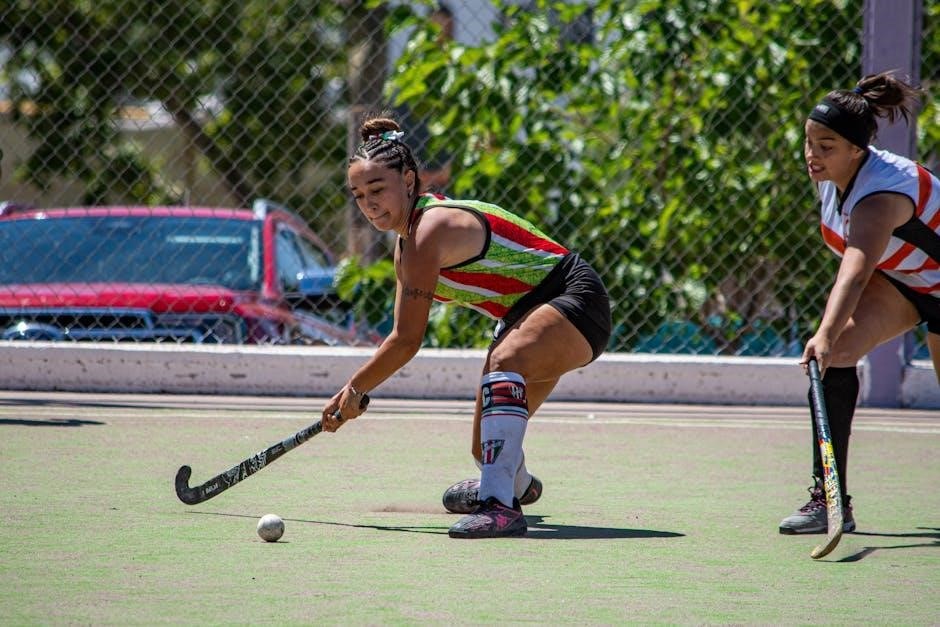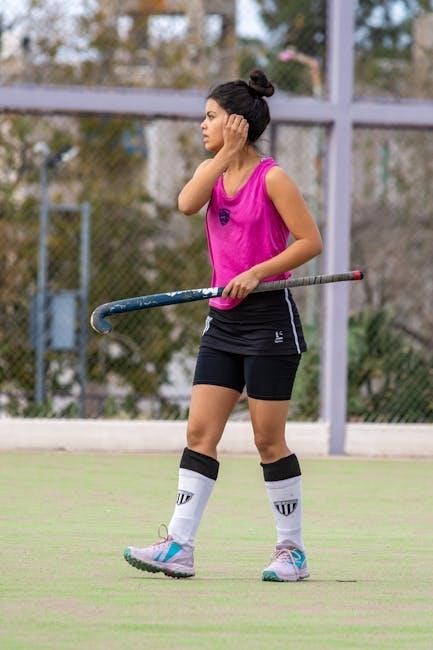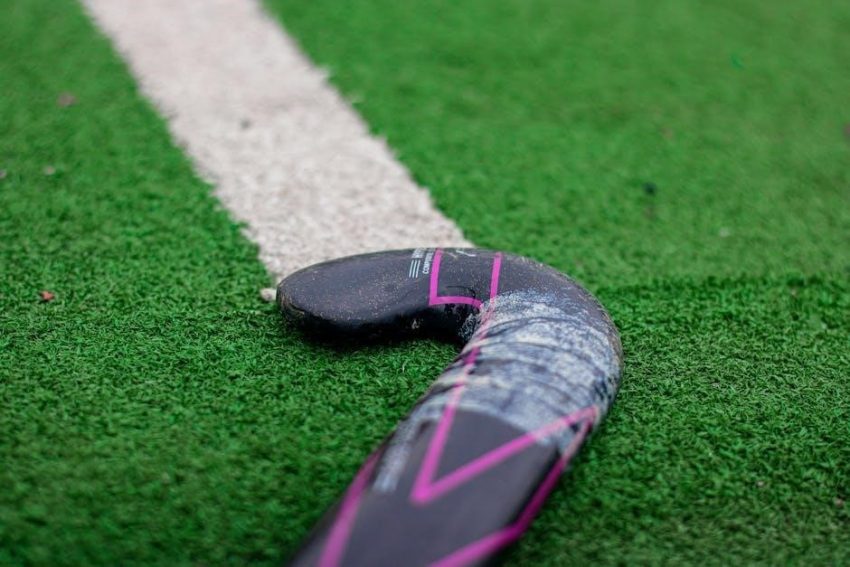Understanding the proper field hockey stick length is crucial for optimal performance, comfort, and control. This guide provides essential insights to help players choose the ideal stick length, ensuring a perfect fit and enhanced gameplay.
1.1 Importance of Proper Stick Length
Proper stick length is crucial for optimal performance, comfort, and control in field hockey. A well-fitted stick enhances ball control, maneuverability, and accuracy, while an ill-fitting one can hinder skills and lead to discomfort. Players with sticks too long or short may struggle with passing, hitting, or dribbling, potentially affecting gameplay and increasing injury risk. Ensuring the right length is essential for maximizing efficiency and safety on the field.
1;2 Overview of Stick Length Regulations
Field hockey stick length is regulated to ensure fair play and safety. The maximum allowed length is 38 inches, with no specified minimum. Sticks must also meet bow restrictions, as the bow cannot exceed 25mm in height, and curvature limits are set at 25mm. These regulations, governed by the FIH, apply to materials like wood and composite sticks, ensuring consistency across all players. Adhering to these standards is essential for maintaining game integrity and player safety. Proper stick length is a critical aspect of the game.

Field Hockey Stick Regulations
Field hockey sticks must adhere to specific regulations, including a maximum length of 38 inches and bow restrictions of 25mm; Curvature limits and material standards are also enforced to ensure fair play and safety.
2.1 Maximum Length Allowance
The maximum allowed length for a field hockey stick is 38 inches, as specified by regulations. This measurement ensures fair play and safety across all levels of competition. While there is no minimum length requirement, sticks shorter than 28 inches are uncommon. The maximum length promotes consistency and prevents excessive reach advantages. Adhering to this regulation is crucial for maintaining game integrity and ensuring players can control the stick effectively. Proper stick length also enhances performance and maneuverability on the field.
2.2 Minimum Length Requirements
There is no official minimum length requirement for field hockey sticks, allowing flexibility for younger or shorter players. However, sticks shorter than 28 inches are uncommon and typically used by very young juniors. The practical lower limit is around 28 inches, ensuring the stick remains functional for basic skills like dribbling and hitting. While shorter sticks can be customized, they must still meet safety and performance standards set by governing bodies like the FIH. Proper sizing is key to maintaining control and effectiveness on the field.
2.3 Bow Restrictions and Curvature Limits
Field hockey sticks must adhere to specific bow restrictions, with a maximum height of 25mm and curvature limited to 25mm. These regulations ensure fair play and maintain the stick’s functionality. The bow’s design affects handling and ball control, making it essential to comply with FIH standards. Exceeding these limits can result in the stick being deemed illegal for competition. Proper bow dimensions balance performance and rule adherence, ensuring a level playing field for all athletes.
Size Charts for Field Hockey Sticks
Size charts provide a detailed guide to selecting the ideal stick length based on height, ensuring optimal performance and comfort for players of all levels and positions.
3.1 Junior Stick Size Recommendations
Junior field hockey sticks typically range from 24 to 34 inches in length, catering to players of varying heights and ages. For younger players, sticks around 28-30 inches are ideal, while taller juniors may opt for 32-34 inches. Proper sizing ensures comfort and skill development, allowing young players to control the ball effectively. The stick should reach the hip bone or belly button when standing upright, providing optimal balance and maneuverability during gameplay. Correct sizing is essential for juniors to master fundamental skills without strain;
3.2 Senior Stick Size Recommendations
Senior field hockey sticks typically range from 35 to 38 inches in length, designed for adult players. The ideal stick length correlates with the player’s height, ensuring optimal performance and control. Taller players often prefer longer sticks for better reach, while shorter players may opt for slightly shorter lengths. Proper sizing is crucial to maintain balance and effectiveness on the field, allowing seniors to execute skills like dribbling, passing, and shooting with precision and confidence.
3.3 Comparison of Junior and Senior Stick Sizes
Junior field hockey sticks are shorter, ranging from 28 to 35 inches, designed for younger players to enhance control and skill development. Senior sticks, measuring 35 to 38 inches, are longer and tailored for adult players, offering greater reach and power. The size difference reflects the physical growth and gameplay demands of players, ensuring optimal performance at each developmental stage. Proper sizing for both juniors and seniors is essential for maximizing effectiveness and comfort on the field;

How to Measure Field Hockey Stick Length
Measure the stick from the floor to the top of the hip bone or belly button while standing upright. This ensures a proper fit for optimal control and performance.
4.1 Measuring from the Floor to the Hip Bone
Stand upright and place the stick vertically beside you, with the head on the ground. Measure from the floor to the top of your hip bone. This method ensures the stick reaches just below your waist, providing comfort and control. The hip bone measurement is a standard reference point, allowing players to maintain proper posture and grip. This approach is particularly recommended for midfielders and forwards, as it balances reach and maneuverability. Always ensure the stick feels natural and suits your playing style.
4.2 Measuring from the Floor to the Belly Button
Another common method is measuring from the floor to the belly button while standing upright. This technique is particularly useful for younger players or those with shorter torsos. The stick should align with the belly button when held vertically. This measurement ensures the stick is proportional to the player’s height, providing optimal control and maneuverability. It’s a simple yet effective way to determine the ideal length, especially for juniors or those still growing. Always consider personal comfort and playing style when finalizing the measurement.
4.3 Step-by-Step Guide to Measuring Stick Length
Stand upright with your feet shoulder-width apart. 2. Place the stick vertically beside you, with the head touching the ground. 3. The top of the stick should reach the middle of your hip bone or belly button. 4. Ensure the stick feels comfortable and balanced. 5. Adjust the length based on personal preference and playing style. This method ensures accuracy and helps determine the ideal stick length for optimal performance and control on the field.

Factors Influencing Stick Length Selection
Player height, position, and skill level are key factors in selecting the ideal stick length. Taller players often prefer longer sticks, while shorter players opt for shorter lengths. Forwards may choose different lengths than defenders, and skill level influences preferences for control or power.
5.1 Player Height and Stick Length Correlation
Player height is a key factor in determining the ideal field hockey stick length. Generally, taller players benefit from longer sticks for better reach, while shorter players prefer shorter sticks for easier control. The recommended stick length typically ranges from 28 to 38 inches, with specific guidelines based on height. For example, a player under 4 feet may use a 28-inch stick, while a player around 5’10” to 6’4″ might opt for a 37.5-inch stick. This correlation ensures optimal performance and comfort.
5.2 Playing Position and Stick Length
A player’s position significantly influences the ideal field hockey stick length. Forwards often prefer shorter sticks for agility and quick handling, while defenders opt for longer sticks to enhance reach and power. Midfielders typically choose medium lengths to balance agility and reach. Goalkeepers use specialized sticks, often longer with unique head shapes for blocking. Tailoring stick length to position ensures better control, maneuverability, and performance, allowing players to excel in their specific roles on the field.
5.3 Skill Level and Stick Length Preferences
Players’ skill levels significantly influence their stick length preferences. Beginners often opt for shorter sticks, which are easier to control and maneuver. Intermediate players tend to prefer medium lengths, allowing for better ball control and striking power. Advanced players, especially those prioritizing power and precision, may choose longer sticks. Skill level dictates how effectively a player can handle the stick’s weight and length, ensuring optimal performance tailored to their expertise and playing style on the field.

Materials and Their Impact on Stick Length
Wooden sticks are heavier and longer, while composite sticks offer lighter, more durable options. The choice of material affects both the stick’s length and its performance.
6.1 Wooden vs. Composite Sticks
Wooden sticks are heavier and longer, offering a traditional feel, while composite sticks are lighter and more durable, often preferred by elite players. The choice between wooden and composite impacts both stick length and performance, with composite sticks typically offering better control and power due to their advanced material technology. Players often select based on their skill level and playing style, as composites provide a competitive edge in modern field hockey.
6.2 Weight Variations and Their Effect on Length
Stick weight significantly impacts performance, with options ranging from super light (520-535g) to super heavy (625-660g). Lighter sticks enhance speed and agility, while heavier sticks provide more power. The weight often correlates with length, as lighter sticks are typically shorter and easier to maneuver, whereas heavier sticks are longer, offering more reach and strength for defensive plays. Players must balance weight and length based on their position and playing style for optimal efficiency and control.

Choosing the Right Stick for Your Position
Stick length varies by position, with forwards favoring shorter sticks for agility, midfielders opting for medium lengths, and defenders preferring longer sticks for power and reach in gameplay.
7.1 Forwards and Stick Length
Forwards typically prefer shorter sticks, around 34-35 inches, to enhance agility and ball control. A shorter stick allows for quicker stick handling and precise movements, essential for dodging opponents and scoring goals. This length provides better maneuverability, enabling forwards to maintain control during high-speed plays and tight spaces. While personal preference varies, shorter sticks are generally recommended for forwards to optimize their offensive performance and effectiveness on the field.
7.2 Midfielders and Stick Length
Midfielders often opt for medium-length sticks, typically between 35-36 inches. This length balances reach, control, and versatility. A medium stick allows midfielders to cover more ground defensively while maintaining the ability to control the ball effectively during transitions. It provides adequate reach for passing and tackling without compromising agility, making it ideal for players who need to perform both offensive and defensive roles seamlessly.
7.3 Defenders and Stick Length
Defenders often prefer longer sticks, typically ranging from 36 to 38 inches. The additional length provides greater reach for intercepting passes and tackling opponents effectively. A longer stick allows defenders to cover more ground and maintain control while defending, making it easier to clear the ball from the defensive zone. However, it’s important to ensure the stick remains manageable to avoid compromising agility and reaction time during fast-paced defensive situations.
7.4 Goalkeepers and Stick Length
Goalkeepers typically use slightly shorter sticks compared to other positions, usually between 34 and 35 inches. This shorter length provides better control and maneuverability when handling the ball and making quick saves. The reduced length also allows for easier movement within the goal area, ensuring agility and precision in defensive actions. Additionally, the shorter stick helps in rapid passing and clearing, which are critical skills for a goalkeeper in maintaining defensive stability and initiating counterattacks effectively.

Stick Length and Weight Considerations
Stick length and weight are closely linked, with longer sticks often being heavier. Balancing these factors ensures optimal performance, as excessive weight can hinder agility and control.
8.1 Super Light Weight Sticks
Super light weight sticks (520-535 grams) are designed for maximum agility and precision. Ideal for forwards and skilled players, they enhance dribbling and ball control. Lightweight sticks allow for faster swing speeds, enabling quick passes and shots. However, they may lack durability compared to heavier options, making them less suitable for powerful hitters or defensive play. Balancing weight and performance is key to optimizing gameplay with super light sticks.
8.2 Light Weight Sticks
Light weight sticks (535-560 grams) offer a balance between agility and durability, making them versatile for various playing styles. They are suitable for midfielders and forwards seeking quick stick handling without sacrificing strength. Light sticks are easier to maneuver, allowing for precise passes and shots, while maintaining enough weight for solid defensive plays. This range is popular among players who value both speed and control, ensuring a well-rounded performance on the field.
8.3 Medium Weight Sticks
Medium weight sticks (565-590 grams) provide a balance of power and control, making them ideal for players seeking consistent performance. They are durable enough for defensive roles yet light enough for quick offensive moves. This weight range suits experienced players who need reliability and versatility. Medium sticks are a popular choice for midfielders and forwards, offering a stable feel that enhances accuracy and endurance during matches, ensuring adaptability to various game situations and demands.
8.4 Heavy Weight Sticks
Heavy weight sticks (595-620 grams) are designed for players prioritizing power and strength. Ideal for defenders and goalkeepers, they offer increased durability and force for hitting and blocking. However, they can be less maneuverable and tiring for players with high movement demands. These sticks are best suited for experienced players who value robust performance and are comfortable with the added weight, making them a strategic choice for specific roles on the field.
8.5 Super Heavy Weight Sticks
Super heavy weight sticks (625-660 grams) are the heaviest option, offering maximum durability and power. They are typically used by elite defenders and goalkeepers requiring intense strength for clears and saves. These sticks are less common due to their weight, which can impede agility. Players opting for super heavy sticks must balance the added force with reduced speed, making them a niche choice for specialized roles demanding exceptional power and impact.
Common Mistakes in Choosing Stick Length
Players often choose sticks too long or too short, affecting performance and control. A stick too long can reduce maneuverability, while one too short may limit reach and power.
9.1 Choosing a Stick Too Long
Selecting a stick that is too long can hinder performance by making it difficult to control and maneuver. A stick that is overly long may cause the player to hunch or overreach, leading to discomfort and reduced accuracy when passing, shooting, or dribbling. Additionally, a stick that is too long can increase fatigue and slow reaction times, making it harder to respond quickly during gameplay. Proper stick length ensures better technique and overall performance on the field.
9.2 Choosing a Stick Too Short
Selecting a stick that is too short can limit your reach and control, making it harder to manipulate the ball effectively. A stick that is too short may cause you to bend or stretch awkwardly, leading to poor technique and discomfort. Additionally, a shorter stick can reduce your ability to dribble, pass, and shoot with precision, ultimately affecting your overall performance on the field. Proper stick length is essential for maintaining balance and executing skills efficiently.

Tips for Selecting the Ideal Stick Length
Test different stick lengths, consult coaches, and use size charts to find your perfect fit. Ensure comfort, control, and performance by prioritizing proper measurements and personal preference.
10.1 Testing Different Stick Lengths
Testing various stick lengths is essential to determine the most comfortable and effective fit. Players should handle sticks of different sizes to assess balance, control, and ease of movement. Pay attention to how each length feels during drills and gameplay, as this directly impacts performance. Testing allows for a personalized choice, ensuring the stick complements your height, skill level, and playing style. Consulting with a coach can also provide valuable insights during this process.
10.2 Consulting with Coaches or Experienced Players
Seeking advice from coaches or experienced players can greatly aid in selecting the ideal stick length. Their expertise provides valuable insights, helping you understand how stick length relates to your height, position, and playing style. Coaches can assess your technique and recommend lengths that enhance performance, while experienced players offer practical tips based on their own journeys. This collaborative approach ensures a well-informed decision, optimizing both comfort and effectiveness on the field.

Frequently Asked Questions (FAQs)
Players often inquire about optimal stick lengths, customization options, and how length impacts performance. These FAQs address common queries, providing clarity and practical solutions for all players.
11.1 What is the optimal stick length for my height?
The optimal stick length is typically determined by measuring from the floor to the top of the hip bone while wearing shoes. For shorter players (under 4′), a 28-inch stick is recommended, while taller players (over 6′) may prefer a 37.5-inch stick. General guidelines suggest: 4’–4’3″ use 28–30″, 4’4″–4’11” use 32–34″, 5’–5’7″ use 35–36″, and 5’8″–6′ use 36.5–37.5″. Testing different lengths can help ensure comfort and control.
11.2 Can I customize the length of my field hockey stick?
Yes, field hockey sticks can be customized in length to suit individual preferences. Most sticks can be cut to size, but they cannot be extended beyond their original length. Players often shorten their sticks for better control, ensuring the end reaches just below the hip bone. Cutting the stick may void the manufacturer’s warranty, so measure carefully before making adjustments. Customizing length is common, especially for younger players, to ensure optimal performance and comfort.
11.3 How does stick length affect performance?
Stick length significantly impacts a player’s performance, affecting control, power, and accuracy. A stick that is too long can feel unwieldy, reducing precision, while a stick that is too short may limit reach. Proper length enhances dribbling, passing, and hitting skills, ensuring optimal technique. A well-fitted stick improves balance and maneuverability, allowing players to perform at their best. Stick length must align with the player’s height and position to maximize efficiency and comfort on the field.
Selecting the right field hockey stick length is vital for performance and comfort. Use the provided size charts and guidelines to ensure an optimal fit and enhance your game.
12.1 Final Thoughts on Choosing the Right Stick Length
Choosing the right field hockey stick length is a balance of fit, comfort, and performance. Stick length correlates with player height, impacting skills like passing, hitting, and dribbling. Proper length enhances control and reduces fatigue. Use size charts as a guide but consider personal preference and playing style. Testing different lengths and consulting experts can refine your choice. Remember, the optimal stick length is one that feels natural, allowing you to play confidently and effectively.
12.2 Encouragement to Use the Size Chart
Using a field hockey stick size chart is essential for ensuring a proper fit, which directly impacts performance and comfort. These charts provide a reliable starting point, correlating stick length with player height. While personal preference plays a role, adhering to the guidelines helps avoid common issues like sticks being too long or too short. Referencing the chart ensures you find a stick that complements your height and playing style, enhancing your overall field hockey experience.

Resources for Further Reading
For more insights, explore official field hockey association guides, manufacturer websites, and expert articles. These resources offer detailed advice on stick sizing and selection.
13.1 Field Hockey Stick Size Charts
Field hockey stick size charts are essential tools for determining the ideal stick length based on a player’s height. These charts typically categorize stick lengths from 28 to 38 inches, with specific recommendations for junior and senior players. For example, a player measuring 4 feet or shorter may use a 28-inch stick, while taller players opt for longer lengths up to 38 inches. Reputable sources like the FIH and manufacturers provide detailed charts to help players make informed decisions.
13.2 Guides from Reputable Hockey Associations
Reputable hockey associations, such as the FIH (International Hockey Federation), provide official field hockey stick length guides to ensure compliance with global standards. These guides outline precise measurements, materials, and bow restrictions, helping players and retailers understand regulations. They also offer recommendations for stick length based on player height and position, ensuring consistency and fairness in the sport. These resources are invaluable for anyone seeking to purchase or verify the legitimacy of a field hockey stick.
